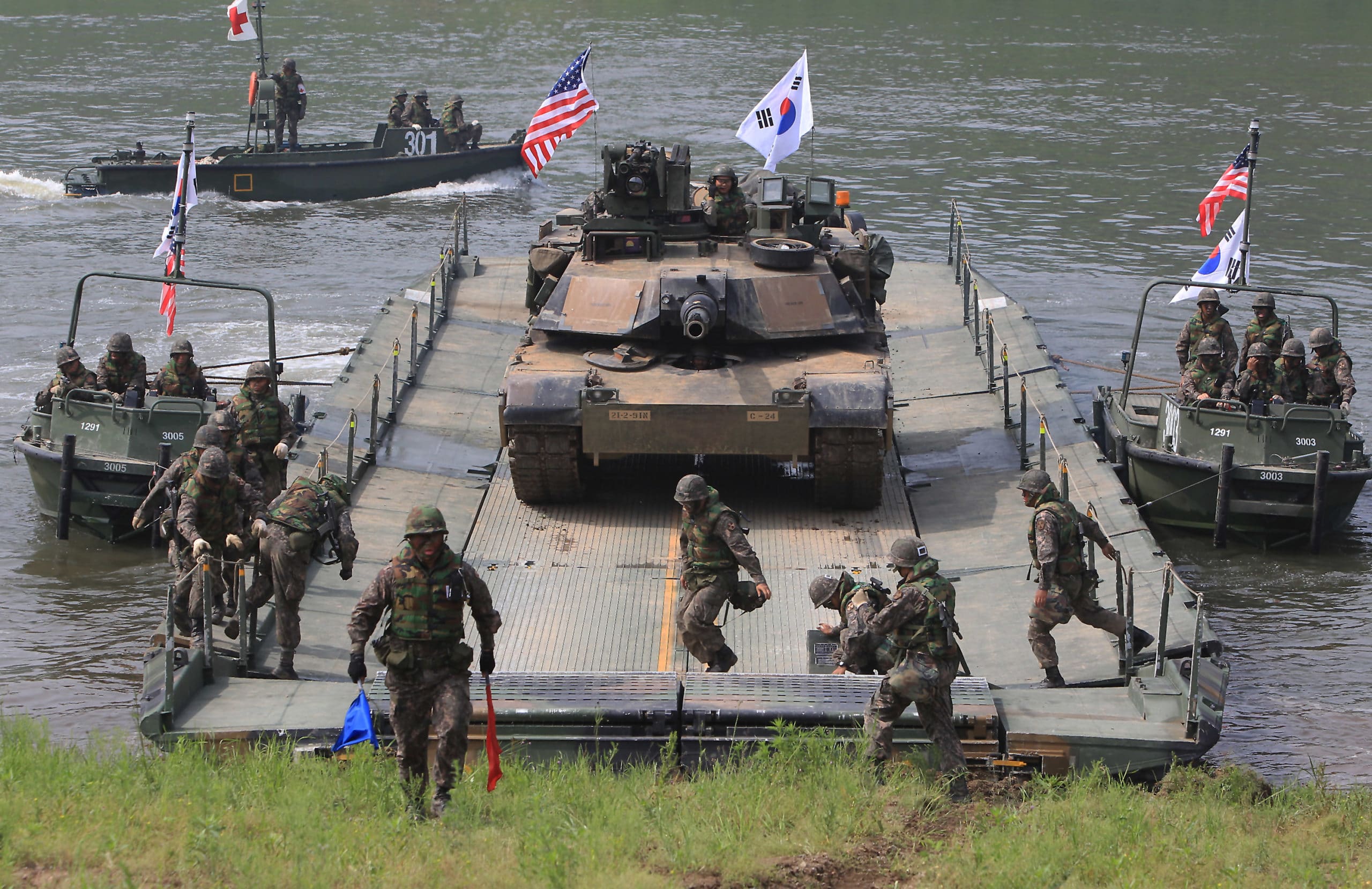December 15, 2020 | Defending Forward Monograph
Partnering With Seoul to Deter Pyongyang
December 15, 2020 | Defending Forward Monograph
Partnering With Seoul to Deter Pyongyang
The U.S. military presence on the Korean peninsula protects vital U.S. interests in the region and deters military attack by North Korea against the U.S. homeland or America’s South Korean ally. The Trump administration, however, has pursued burden sharing negotiations with Seoul in a manner that undermines American interests and the U.S.-ROK alliance. A review of U.S. interests, as well the leading threats to those interests, demonstrates the importance of recommitting to U.S. combat power in South Korea.
North Korea is often derided as a “hermit kingdom,” cut off from the technologies and advances of the modern world. But the threat from North Korea cannot be ignored. It has continued to develop and deploy a ballistic missile arsenal capable of ranging the continental United States. These missiles include the Hwasong-14 and Hwasong-15 intercontinental ballistic missiles (ICBMs).1 Experts estimate North Korea possesses between 30 and 60 nuclear weapons.2 To make matters worse, the North seeks to miniaturize nuclear warheads to mount on these ICBMs. It is likely North Korea’s nuclear and ICBM tests in 2017 were designed to further this goal as well as send a warning to the U.S. during the year of “fire and fury.”3 North Korea has not conducted an ICBM test since November 2017 but continues to advance its ballistic missile program.4
However, on October 10, 2020, at a military parade celebrating the 75th anniversary of the founding of the Workers Party of Korea, Pyongyang introduced two new, untested missile systems: a possible Hwasong-16 ICBM and a possible Pukguksong-4, a submarine-launched ballistic missile.5 In addition, the regime displayed a wide variety of advanced conventional weapons, showing marked improvement since the 70th anniversary parade.6 These developments reveal that Pyongyang has continued evading sanctions and undermining the U.S. “maximum pressure” campaign. North Korea has continued to develop its military capabilities primarily to achieve its seven-decades-old goal of unifying the Korean peninsula under the North Korean totalitarian family dynasty.7 The North Korean military represents an existential threat to South Korea – one of America’s important democratic partners in a turbulent region – and Pyongyang’s ICBMs pose a direct threat to the United States.8
Pyongyang’s military, the fourth-largest in the world, threatens South Korea and Japan.9 Although equipped with mostly outdated Russian equipment backed by an antiquated communist military doctrine, the North’s numerical advantage is formidable. North Korea’s 1.2 million active-duty personnel double the 600,000 troops fielded by South Korea’s military.10 North Korea deploys 70 percent of its forces between Pyongyang and the Demilitarized Zone (DMZ) – around 30 miles or less from Seoul. The North also positions its artillery and rocket arsenal just north of the DMZ, in range of the greater Seoul metropolitan area, which is home to more htan 25 million South Koreans and 150,000 Americans.11 This threatens millions of innocent lives.12
Pyongyang also has developed a wide range of asymmetric capabilities to offset weaknesses inherent in its obsolete equipment and vastly inferior economy.13 These include chemical and biological weapons,14 advanced cyber operations,15 and one of the world’s largest special operations forces.16 North Korea is also developing and fielding thousands of short- and medium-range missiles and rocket systems designed to threaten U.S. and ROK bases across the peninsula.17
If North Korea were to attack South Korea, the human and economic consequences would be staggering. It is worth remembering that over 2 million Koreans and 36,574 Americans lost their lives in the Korean conflict.18 Furthermore, war could also spill over beyond the peninsula, resulting in North Korean ballistic missile, cyber, and unconventional warfare attacks on Japan, for example. Such a conflict could also lead to direct clashes between China and the United States – as it did in 1950.
The United States has belatedly sprinted to improve homeland missile defense against a potential North Korean ICBM attack on the American homeland. These defenses against a limited North Korean ICBM attack provide an element of deterrence by denial. However, as Pyongyang builds its ICBM and nuclear programs, the United States needs credible deterrence by punishment, too. The forward U.S. military presence in South Korea provides just that. In 1997, the highest ranking defector from North Korea, Hwang Jang-yop, openly stated that the presence of U.S. forces in South Korea is the only thing deterring North Korean aggression.19
The U.S. presence in the South is not insignificant. There are 28,500 U.S. troops assigned to United States Forces Korea.20 In addition, a U.S. Army Brigade Combat Team rotates to South Korea every nine months. Strategic assets from the U.S. Air Force and Navy, including bombers, submarines, and aircraft carrier strike groups, routinely deploy to the Korean theater and exercise with South Korean forces.21 The largest component of forward-stationed U.S. forces is the Eighth U.S. Army, with the majority of troops based at Camp Humphreys, which is the largest U.S. military installation outside the United States.22 That facility was completed in 2018 at a cost of approximately $10.7 billion.23 South Korea provided 90 percent of the funding, which fell outside the scope of the normal Special Measures Agreement process.24 Many of these U.S. Army forces serve as the enablers to safely and effectively surge large-scale U.S. ground forces during a crisis or war with North Korea.
The 7th Air Force consists of two fighter wings at the Osan and Kunsan air bases. The U.S. Navy, Marine Corps, and Special Operations components consist only of headquarters, which support the rotational deployment of U.S. forces for planning, training, and exercises.25

U.S. Army’s M1A2 tank and soldiers and South Korean soldiers participate in a river crossing exercise in Yeoncheon-gun, South Korea. (Photo by Chung Sung-Jun via Getty Images)
After decades of partnership and deterrence, the U.S.-ROK relationship has recently come under strain.26 Ignoring the clear benefits of the U.S. military presence in South Korea, the Trump administration has pushed Seoul to contribute more to offset the costs of stationing U.S. forces. While discrete disagreements over burden sharing between allies every few years are commonplace, the Trump administration’s obstreperous approach has introduced new and unnecessary tension into the relationship. Beijing, Moscow, and Pyongyang could not be more pleased.
President Trump has reiterated his desire to bring U.S. troops home “at some point.”27 Special Measures Agreement negotiations stalemated in the summer of 2020 after Trump demanded South Korea increase burden sharing by 400 percent.28 The administration’s surprise announcement that it would withdraw 9,500 U.S. troops from Germany unsurprisingly put removal of troops from Korea in the spotlight.29
Pyongyang would perceive a significant U.S. military withdrawal from South Korea as evidence of a declining U.S. willingness to honor its treaty commitments to South Korea. This could invite the North Korean military aggression that America’s military presence has deterred for decades. Withdrawal would also represent a gift to Beijing, which is eager to see the U.S. military depart the region. Such a move might even force Seoul and other U.S. allies in Asia to consider further accommodating Beijing’s interests.
The cost savings for America, it should be noted, are far from clear. It is not inexpensive to move up to 28,500 troops, their dependents, and their equipment off the peninsula. The Pentagon would be forced to spend billions of finite dollars on personnel moves and new military construction projects for a withdrawal that would reduce military readiness and make America less safe.
Congress has expressed bipartisan concern regarding any potential withdrawal of U.S. troops from South Korea. Most recently, in the National Defense Authorization Act for Fiscal Year 2021 Conference Report, Congress included section 1258, which would make it more difficult to reduce the number of U.S. troops in South Korea below 28,500 troops – the current level there.30
Going forward, Washington should certainly continue to press Seoul during the Special Measures Agreement negotiation process to ensure fair and equitable burden sharing.31 But Washington should not do so at the expense of other U.S. interests or with unrealistic expectations of America’s Korean allies. South Korea is not a freeloader; Seoul spends nearly 2.7 percent of GDP on defense, one of the highest rates among the world’s democracies.32 Negotiations should account for all types of support, and the agreement should be implemented for the traditional five-year period. In addition, Washington should reach an agreement with South Korea on strategic flexibility, which will more easily allow the United States to use U.S. forces on the Korean Peninsula to support training, exercises, and contingencies in the Indo-Pacific region.33
As part of a review of U.S. military posture, the Pentagon should assess what is required in South Korea to defend America’s interests and deter North Korean aggression. If the Defense Department conducts an objective appraisal, there may be ways to reduce America’s footprint or shift some additional burden to South Korea, but the Pentagon will also find that a significant U.S. military withdrawal from South Korea would be unwise, even dangerous.34
